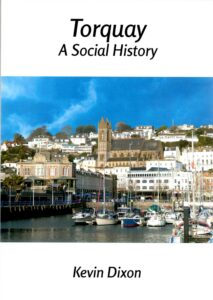The Chapel Ghost
St Michael’s Chapel is a mystery. We don’t know its real name, who built it, when they built it, and what it was for.
As with many ancient places on the edge of communities, legends arise and over time become more elaborate as they are related by firesides and in taverns. For good practical reasons, forested and steep-sided areas are particularly thought of as being haunted or hazardous for the unwary, and by the twentieth century children were being told of murderous and predatory tramps living in Chapel Woods. Such stories were a good way of getting out safety messages.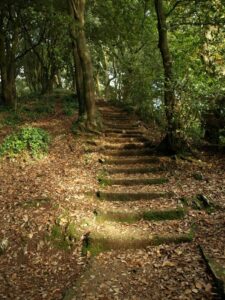 But there is an older legend, that of the Hermit’s Ghost.
But there is an older legend, that of the Hermit’s Ghost.
The folk tale inevitably involves a spectre, a beautiful maiden and a lesson in morality. The story is related in the 1850 book ‘Legends of Torquay’ and is repeated in Arthur Charles Ellis’ ‘Historical Survey of Torquay’ in 1930.
Here’s a synopsis.
One night a terrible storm raged while Torre Abbey’s white-robed canons were praying. Suddenly a man rushes in to announce that a vessel was drifting on to Abbey Sands. The canons rushed to the beach to find a ship illuminated by lightning flashes. Though beacons were lit, the ship foundered with all the crew being lost except for one survivor who was carried to the Abbey and nursed back to full health. 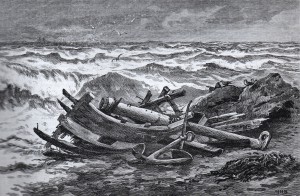 In thanks for his life being saved he decides to devote his remaining days to the service of God. He then built a little chapel on the hill where he could see the spot where his ship was lost. There he lived the rest of his life as a hermit and could be heard praying for the safety of those at sea whenever storms raged in the Bay.
In thanks for his life being saved he decides to devote his remaining days to the service of God. He then built a little chapel on the hill where he could see the spot where his ship was lost. There he lived the rest of his life as a hermit and could be heard praying for the safety of those at sea whenever storms raged in the Bay.
Three hundred years after the hermit’s death a youth arrives at the chapel seeking knowledge. He is, however, dismissive of the story of the hermit’s dedication. While contemplating his place in the universe he falls asleep and dreams that he finds his way inside the chapel, finding it brilliantly illuminated by two lamps in the recess of the northern wall. He is joined by an old man with long white hair who reproaches him for his scepticism. The elderly Hermit, for it is he, prophesies that one day the young man will be grateful to the builder of the chapel. Our hero then awakens.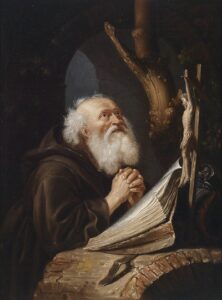 Time passes and the young man falls in love with a fair maid by the name of Rosalind. Our Torquay couple often discuss the strange dream as they sat on the grass outside the chapel.
Time passes and the young man falls in love with a fair maid by the name of Rosalind. Our Torquay couple often discuss the strange dream as they sat on the grass outside the chapel.
It may be significant that the name of Rosalind would be familiar to most people in the early modern period. Rosalind is the beautiful protagonist of Shakespeare’s play ‘As You like It’ (1600) and exemplifies the best of the virtues to be found in a Renaissance English woman. Youthful, intelligent and witty she is the faithful lover of Orlando and a similar loyal personality to the Torquay Rosalind who we will come to know as this mawkish tale unfolds.
Soon the romantic couple part as our hero travels across the sea, not expecting to return for three years. Rosalind promises to visit the chapel on every anniversary of his departure and does so though, after three years, her lover still hadn’t returned. 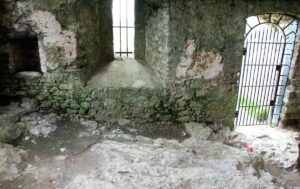 On the final anniversary Rosalind journeys through another terrible storm to the Chapel, reaching the summit of the hill late at night. She is surprised to see a light burning and, on entering the porch, sees an old man who she recognises from her lover’s description.
On the final anniversary Rosalind journeys through another terrible storm to the Chapel, reaching the summit of the hill late at night. She is surprised to see a light burning and, on entering the porch, sees an old man who she recognises from her lover’s description.  The hermit tells her that her true love is in the Bay in an imperilled ship battling the elements. For a bit of added melodrama, he concludes with, “Since these strong walls were raised no storm has swept along this coast like that which comes tonight”.
The hermit tells her that her true love is in the Bay in an imperilled ship battling the elements. For a bit of added melodrama, he concludes with, “Since these strong walls were raised no storm has swept along this coast like that which comes tonight”. Together they leave the chapel and make their way to the beach to find an apparently lifeless body in the shallow waters. Dragging the man to safety they then take him to the nearest habitation. As often happens in these tales, Rosalind promptly faints. On waking she is greeted by her recovered long-lost love.
Together they leave the chapel and make their way to the beach to find an apparently lifeless body in the shallow waters. Dragging the man to safety they then take him to the nearest habitation. As often happens in these tales, Rosalind promptly faints. On waking she is greeted by her recovered long-lost love.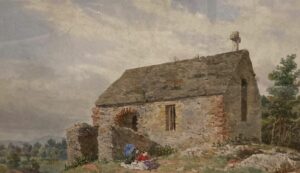 Though the storm has ended the old man has lingered on and delivers a lengthy address. Presumably after three hundred years of being alone he had plenty of time to prepare a speech, worth repeating here in full to make a point.
Though the storm has ended the old man has lingered on and delivers a lengthy address. Presumably after three hundred years of being alone he had plenty of time to prepare a speech, worth repeating here in full to make a point.
“Tell him, my child, that even he who scoffed at it erewhile, has cause for thankfulness for my pious work. Not always am I permitted to visit earth, in my earthly form, but for some good end or wise design. But, maiden, hear my latest words.
“When any shall seek the grey chapel yonder, with reverence and worship in their hearts, to muse on good times gone by, the spirit such meditations invoke shall leave within each breast some lasting good. When any shall seek it in sorrow and distress the same spirit shall soothe and comfort their hearts.
“When any shall come to bewail some bygone sin and drop the penitential tear upon the rugged floor, not idle will that spirit be to teach their hearts aright and lead to hope and life. Farewell. Remember me.” The verbose hermit then disappears, our informants tell us, though the story has been handed down through the ages.
The verbose hermit then disappears, our informants tell us, though the story has been handed down through the ages.
Who committed this wordy missive to paper is unclear, but does point to the Victorian Gothic milieu. It seems as though we have an anonymous melodramatic and sensational romance for the consumption of the masses. Indeed, one way to tell if a folk story is of a real event, rather than a work of entertaining fiction, is the amount of detail and dialogue presented. Indeed, there doesn’t seem to be any record of the story or the ghost before 1850 when that anonymous ‘Legends of Torquay’ was published.
The Romantic Chapel
Enhancing the Chapel’s mythos was the fiction writer Elizabeth Goudge (1900-1984). While a resident of Marldon, Elizabeth authored several books with the village as a setting, including references to Berry Pomeroy Castle, the village of ‘Smokey’, and the fields of Cockington. But the book that interests us here is Gentian Hill (1949), specifically its retelling of the St Michael’s Chapel legend, and the way that the book has been accepted by some readers as real history.
While a resident of Marldon, Elizabeth authored several books with the village as a setting, including references to Berry Pomeroy Castle, the village of ‘Smokey’, and the fields of Cockington. But the book that interests us here is Gentian Hill (1949), specifically its retelling of the St Michael’s Chapel legend, and the way that the book has been accepted by some readers as real history.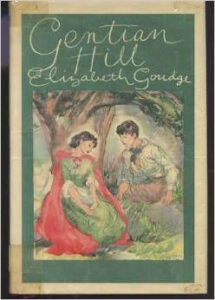 Gentian Hill is set at the time of the Napoleonic Wars. Young Midshipman Anthony O’Connell, deserts his ship at Torquay and escapes into the countryside where he meets and falls in love with Stella Sprigg, the adopted daughter of local farmers.
Gentian Hill is set at the time of the Napoleonic Wars. Young Midshipman Anthony O’Connell, deserts his ship at Torquay and escapes into the countryside where he meets and falls in love with Stella Sprigg, the adopted daughter of local farmers. Elizabeth intertwines the Anthony and Stella story with the legend of St. Michael’s Chapel as she explains in her introduction, “This story is a retelling of the legend of St. Michael’s Chapel at Torquay… it’s elaboration is my own invention, though the story has come to me so vividly from this bit of country that I have hard work to believe it is not true.”
Elizabeth intertwines the Anthony and Stella story with the legend of St. Michael’s Chapel as she explains in her introduction, “This story is a retelling of the legend of St. Michael’s Chapel at Torquay… it’s elaboration is my own invention, though the story has come to me so vividly from this bit of country that I have hard work to believe it is not true.”
This nineteenth century saga appealed to Elizabeth’s Christian worldview of sacrifice, self-discipline, healing, and growth through suffering. She took myths and legends and transformed them into guides to find, as she put it, the “eternal, immortal, invisible, the only wise God”. Elizabeth also makes use of the Abbey-Chapel tunnel in her story and so reinforced the belief in the Torquay hypogeal. 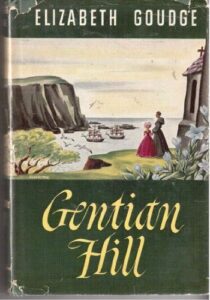 At the conclusion of the story-within-a-story, the St Michael’s Chapel guardian then takes on another inspirational role: “And always the Holy hermit prays like Moses upon the hilltop or high in the watch tower.”
At the conclusion of the story-within-a-story, the St Michael’s Chapel guardian then takes on another inspirational role: “And always the Holy hermit prays like Moses upon the hilltop or high in the watch tower.”
That was Elizabeth’s gift, to take the ancient and turn it into a lesson on how to live. She wrote: “As this world becomes increasingly ugly, callous and materialistic it needs to be reminded that the old fairy stories are rooted in truth, that imagination is of value, that happy endings do, in fact, occur, and that the blue spring mist that makes an ugly street look beautiful is just as real a thing as the street itself”.
The Chapel’s Observatory
There are other ruins next to the chapel. All that now remains are a few graffiti-covered walls, but these were once vital to Torquay’s tourism industry.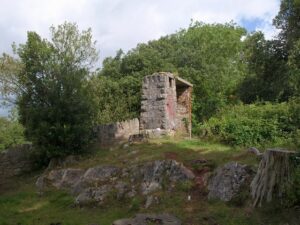 This was the Borough Meteorological Observatory which operated between 1888 and 1902. The Observatory was sited on the hill for its uninterrupted views and built on solid limestone to prevent vibration at the summit of the quarry.
This was the Borough Meteorological Observatory which operated between 1888 and 1902. The Observatory was sited on the hill for its uninterrupted views and built on solid limestone to prevent vibration at the summit of the quarry.
The Observatory was initiated and maintained by Torquay Town Council, under the supervision of the Royal Meteorological Society and during its short life was operated by Alfred Chandler.
I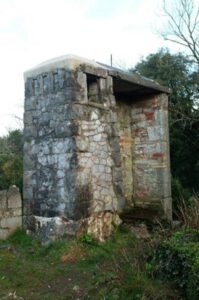 n its early days, the need for rapid and accurate weather information was of most use to the sailing community. Torquay was, however, increasingly promoting itself as Britain’s most elite holiday resort and so the findings of the Observatory were of real importance for the town. We had good weather and we needed to tell everybody about it as soon as we could. There was acute competition for visitors… and for the right ‘type’ of visitors.
n its early days, the need for rapid and accurate weather information was of most use to the sailing community. Torquay was, however, increasingly promoting itself as Britain’s most elite holiday resort and so the findings of the Observatory were of real importance for the town. We had good weather and we needed to tell everybody about it as soon as we could. There was acute competition for visitors… and for the right ‘type’ of visitors.
And we became exceptionally proficient at announcing our unique attributes to the nation and the world. In 1897 Plymouth’s Meteorologist H Prigg acknowledged Torquay’s promotional success. He wrote, “It is undoubtedly by these means (the system for distributing by telegraph the daily weather at Torquay) that the Climate of Torquay is so widely known and so fully appreciated.”
Daring the latter part of the nineteenth century each year Torquay’s Observatory issued two thousand five hundred ‘Afternoon Reports of the Weather’ by Telegram which were published daily in newspapers across the nation under the titles ‘Weather at the South, Torquay’ or ‘Weather at the Sea-side Resorts.’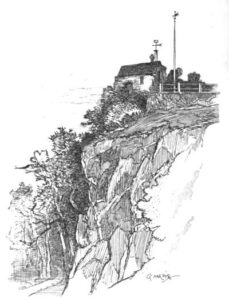 The Observatory became a tourist attraction in its own right, and many visitors came to view these new wonders of science and to take way printed reports. But technology moves on and requires more space. So, in 1902 the Observatory closed, and the equipment was moved to the end of Princess Pier. But for those 14 years what is now a ruin in the woods was Torquay’s main way of advertising itself to the world.
The Observatory became a tourist attraction in its own right, and many visitors came to view these new wonders of science and to take way printed reports. But technology moves on and requires more space. So, in 1902 the Observatory closed, and the equipment was moved to the end of Princess Pier. But for those 14 years what is now a ruin in the woods was Torquay’s main way of advertising itself to the world.
Hewn from local limestone, secured to the crest of a lonely outcrop, this accumulation of structures has overseen and paralleled the evolution of Torquay; a Saxon hamlet, a rich and powerful Abbey, a Victorian resort and now an urban conurbation.
An enigma then; an enigma still.
‘Torquay: A Social History’ by local author Kevin Dixon is available for £10 from Artizan Gallery, Lucius Street, Torquay, or:
https://www.art-hub.co.uk/product-page/torquay-a-social-history-by-kevin-dixon



